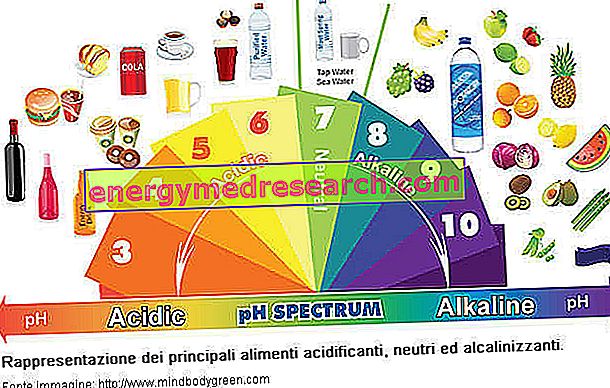Generality
The BLS and the BLS-D are protocols comprising a sequence of first aid actions and maneuvers to be implemented in emergency situations and, in particular, in the event of respiratory and / or cardiac arrest.

The BLS and BLS-D protocols can be put into practice by both health professionals and non-health workers, provided they have followed the appropriate courses held by doctors and qualified operators on behalf of the Italian Resuscitation Council (IRC).
In this article, the BLS and BLS-D protocols for non-healthcare workers will be considered.
What are
What are BLS and BLS-D for Non-Healthcare Operators?
BLS stands for Basic Life Support ( Basic Support of Vital Functions ); while with the acronym BLS-D - Basic Life Support and Defibrillation ( Basic Support of Vital Functions and Defibrillation ) - we refer to the BLS protocol which foresees the use of the defibrillator, normally external semiautomatic.
BLS and BLS-D are protocols that envisage a well-defined sequence of actions that should be implemented when we witness the loss of consciousness of a person who is presumed to have been affected by sudden cardiac death or other disorders capable of carrying respiratory arrest and cardiac arrest.
To learn more: Sudden Cardiac Death »What are they for
What are BLS and BLS-D for Non-Healthcare Workers for?
The set of maneuvers envisaged by the BLS and BLS-D protocols serves to increase the possibility of survival of the individual affected by sudden cardiac death or disorders that lead to cardiorespiratory arrest.
In particular, the main purpose of the first aid maneuvers included in the BLS and BLS-D protocols (cardiopulmonary resuscitation) is to preserve the cells of the entire body - especially those of the brain - from death caused by the absence of oxygen . When breathing and blood circulation stop, in fact, the body's tissues no longer receive oxygen - an element of fundamental importance for their survival - thus starting a process of cell death. Once this process begins, the chances of surviving as well as the chances of a possible recovery in the absence of damage, especially in the brain, decrease considerably.
Did you know that ...
In the event of cardiac arrest, the individual's chances of survival decrease by 10% every minute if he does not intervene promptly with first aid maneuvers and, specifically, with cardiopulmonary resuscitation .
However, it is important to point out that, even if the BLS and BLS-D protocols are activated, unfortunately, the survival of the individual is not always guaranteed.
BLS and BLS-D courses
BLS and BLS-D courses for Non-Healthcare Operators
Individuals suffering from sudden cardiac death or other disorders that can cause respiratory arrest and / or cardiac arrest have low chances of survival in the absence of prompt intervention. On the contrary, if one intervenes in a timely manner with few and simple first aid maneuvers, the possibility of survival, as well as the possibility of recovery without brain damage, increase considerably.

To guarantee an adequate and timely intervention even in the absence of trained doctors or health professionals, the Italian Resusitation Council proposes the so-called BLS and BLS-D courses for non-healthcare workers . These courses include a theoretical part and a practical part, in which one can exercise with the execution of first aid maneuvers on special mannequins, of course, under the supervision of the instructors who hold the course.
Course Objectives
The aim of the BLS and BLS-D courses is to train "common" citizens to enable them to put into practice first aid maneuvers that could save the lives of those who are affected by sudden cardiac death or disorders that lead to respiratory arrest and cardiac arrest.
Curiosity
"Common" citizens, ie non-healthcare workers, are often referred to as lay operators or rescuers .
The BLS-D course also includes learning the basics of using external semi-automatic defibrillators ( AEDs ), now widespread in many public places (in particular, in large cities) and in gyms, swimming pools, schools, sports fields, clubs, stations, airports, etc.

As part of both the aforementioned courses, the necessary information is provided for putting into practice the first aid and defibrillation maneuvers on adult individuals, with hints on first aid maneuvers to be carried out on individuals in the pediatric age (BLS and BLS-D pediatric).
At the same time, indications are also given on the maneuvers to be performed in the event of foreign body airway obstruction both in adults and in children. In this regard, for more information, we recommend reading the dedicated articles: Pediatric Disruption Maneuvers and Heimlich Maneuver .
Chain of Survival
BLS and BLS-D in the chain of survival
The chain of survival consists of a series of actions that must be followed quickly and in order to increase the chances of survival and / or recovery without brain damage from an individual suffering from cardiac and respiratory arrest.

The term "chain" is used to emphasize the importance of the actions that must be performed in sequence: the execution of the previous action increases the probability of success of the subsequent action, and therefore of the survival of the individual, the ultimate goal of this chain and of the BLS and BLS-D sequences.
Going into more detail, the chain of survival consists of four rings that can be described as follows:
- First link : early recognition and car call to prevent cardiac arrest. In this phase, the rescuer must first of all:
- Evaluate the safety of the surrounding environment before intervening (for example, the presence of smoke, toxic gases, electric current, etc.);
- After assessing safety, recognizing cardiac arrest : a person in cardiac arrest is not conscious, does not breathe - or otherwise does not breathe normally - and has no circulation ;
- After evaluating the status of the individual in need of help, immediately contact the health assistance by calling 118 .
Did you know that ...
The assessment of the individual's state of consciousness is essential to provide the right information to the 118 operator who will answer the call. In fact, in this way, it will be able to better manage the request for help by directing relief to the place of the event, remaining on the line to guide the rescuer in the correct execution of the first intervention maneuvers.
- Second ring : early start of cardiopulmonary resuscitation (CPR) to gain time. The beginning of CPR maneuvers is essential to ensure even minimal blood flow within the body . In this way, in fact, oxygen is transported to the various tissues and, in particular, to the brain.
- Third ring : early defibrillation to restart the heart. Clearly, this ring is only feasible if you are able to use an external semi-automatic defibrillator (BLS-D course), only if there is a defibrillator on hand or if you are with someone who is able to procure it quickly. . Otherwise, cardiopulmonary resuscitation must not be interrupted to go and look for it, but it must be continued until the arrival of 118.
- Fourth ring : early advanced rescue and post-resuscitation treatment . This ring is the exclusive responsibility of health care workers and adequately trained medical and nursing staff.
The first three links in the survival chain can also be put into practice by non-health workers who possess the knowledge necessary for their implementation.
How to Practice It
How do you practice the BLS sequence and the BLS-D sequence?
Sequences BLS and BLS-D substantially coincide with the first three rings of the aforementioned survival chain. As mentioned, these rings can also be put into practice by non-healthcare personnel, provided they have followed the appropriate courses organized by the Italian Resuscitation Council (IRC) and know how to intervene appropriately.
To simplify everything, the main actions of the BLS and BLS-D sequence in the adult will be summarized in the following bulleted list; clearly, all operations should be performed quickly.

- Assessment of the safety of the surrounding environment.
- Evaluation of the individual's state of consciousness by shaking him gently by the shoulders and calling him.
- Evaluation of breathing (normal, not normal or absent).
- Call to 118 during which it is necessary to provide information about the state of the individual (conscious, unconscious, breathing, not breathing, etc.).
- If the individual is not conscious and does not breathe, or otherwise breathes badly, begin cardiopulmonary resuscitation by alternating 30 chest compressions (external cardiac massage - MCE) with 2 ventilations (mouth-to-mouth breathing, or even better mouth-mask breathing - option to prefer when the individual is not known). The frequency of chest compressions should be about two per second (100-120 compressions per minute). Ventilations must last about one second each.
Please note
In the event of obvious trauma (for example, an individual falling from a ladder or scaffolding, an individual hit by a car, etc.) - especially if the head and neck - the person should not be touched, must be left in the position where it was found and cardiopulmonary resuscitation should not be performed by non-healthcare personnel. Of course, it is necessary to call 118 immediately .
- Cardiopulmonary resuscitation should be continued until the defibrillator arrives, if available, or until the arrival of 118.
For more detailed information on the actions to be followed before and during the SPC and for information on the SPC in the pediatric age, see the dedicated article: CardioPulmonary Resuscitation - CPR.
- If the external semiautomatic defibrillator is available and if you are able to use it, turn on the instrument as soon as it is available and follow the instructions provided by the registered voice.
At the arrival of 118, the lay rescuer will have to leave space for the health workers and get away from the rescue person. The latter will be taken in charge and transported to the hospital where he will receive all the necessary care.
Importance and Legal Aspects
Because it is important to know the BLS and BLS-D protocols and legal aspects
Knowledge of the BLS and BLS-D sequences can be extremely important if you are faced with an unconscious individual with probable cardiac arrest and respiratory arrest; therefore, it is clear why it is important that non-healthcare workers are also able to perform basic support operations for vital functions.

However, in this regard it is good to point out that, according to the provisions of the current legislation on the matter, non-health operators are not obliged to intervene, even if they possess the necessary knowledge to carry out first aid maneuvers and have followed the BLS and BLS courses -D. In an emergency situation, in fact, it is plausible that the non-health rescuer is in a panic situation and is unable to act in any way. However, it is required to call 118 .
At the same time it is good to remember that, still according to the provisions of the legislation currently in force (January 2019), if the non-health operator decides to intervene and the individual fails to survive, the lay rescuer is not held responsible for this event .
On the contrary, for health workers, the BLS and BLS-D sequences (if the defibrillator is available) are required to intervene and put into practice if they become necessary.
Please note
It should be noted that the information given here is for illustrative purposes only and does not replace the notions transmitted during the BLS and BLS-D courses for non-healthcare workers held by doctors and professionals in the sector.



